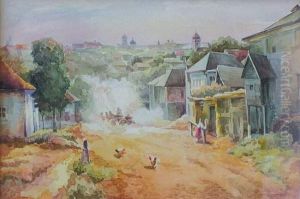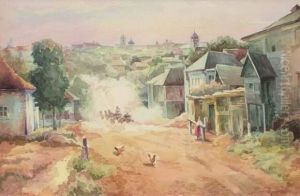Mihail Andrjejevits Berkos Paintings
Mihail Andrjejevits Berkos was a notable figure in the Belarusian art scene during the late 19th and early 20th centuries. Born in 1861, in the Mogilev Governorate of the Russian Empire, which is now part of Belarus, Berkos was a distinguished painter whose work significantly contributed to the cultural and national identity of Belarus.
Berkos embarked on his artistic journey at the Imperial Academy of Arts in Saint Petersburg, where he was exposed to the academic style of painting, excelling particularly in landscape and genre scenes. His education laid the foundation for his artistic philosophy, which later evolved to incorporate elements of realism and national romanticism.
Throughout his career, Berkos was deeply influenced by the natural beauty and rural life of Belarus. His paintings often depicted the serene landscapes, traditional village scenes, and the daily lives of Belarusian peasants, imbued with a sense of realism and a deep, emotional connection to his homeland. Berkos was not just a painter; he was a storyteller who used his canvas to narrate the simple yet profound tales of rural Belarus.
At the turn of the 20th century, Berkos became actively involved in the cultural revival movement in Belarus. His works during this period were marked by a stronger emphasis on national themes and symbols, which resonated with the growing sense of Belarusian national identity. Berkos was not only a pioneer in the visual arts but also played a significant role in the cultural and educational life of Belarus, contributing to the development of art education and the promotion of Belarusian cultural heritage.
Mihail Andrjejevits Berkos passed away in 1919, leaving behind a rich legacy of artistic achievements that continue to inspire and influence the Belarusian art scene. His paintings are cherished not only for their aesthetic value but also for their cultural significance, representing a pivotal moment in the history of Belarusian national art.

